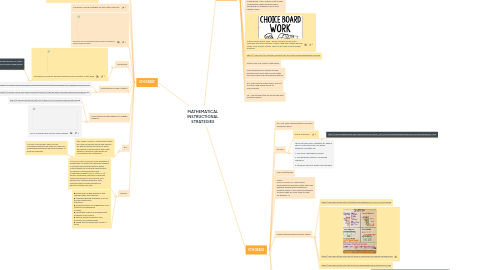
1. 6TH GRADE
1.1. EXPERT GROUPS: Group students into four equal “Expert Groups” that are strategically organized into heterogeneous groups by ability. Then, give each group a topic to cover or task to accomplish. After the experts have learned about their topic or completed their task, they move into new groups to share what they learned with each other.
1.2. MATH BOARD GAMES:
1.2.1. 10 Fun Parent-Tested Math Board Games
1.3. 8 Problem Solving Strategies for the Math Classroom
1.4. ASSIGN AN UNFORGETTABLE MATH PROJECT: Million Dollar Project
1.5. Technology
1.5.1. The features of Reflex: the best math fact fluency system in the world
1.5.1.1. Reflex is a website that teachers can utilize to help their students master mathematical concepts
1.6. Create helpful Anchor Charts!!
1.6.1. https://s-media-cache-ak0.pinimg.com/originals/ba/2e/99/ba2e99524861d017d388ca77f62fb497.jpg
1.6.2. https://s-media-cache-ak0.pinimg.com/originals/b2/1e/3b/b21e3b071fe3d662dabc4ef02a588707.jpg
1.7. Have amazing "Math Methods" to engage students
1.7.1. https://i.pinimg.com/564x/28/e2/74/28e2741776427f6dca07482f4981d7e5.jpg
1.7.2. Top 5 Amazing Rapid Mental Math Methods
1.8. ELL:
1.8.1. KEY WORD CHARTS: Charts that contain key math vocabulary words and phrases are helpful references for ELLs when discussing or writing about their math thinking, especially if the words are accompanied by illustrations.
1.8.1.1. UTILIZE NONVERBAL RESPONSES: Nonverbal responses will help you check for understanding without requiring students to produce language
1.9. GIFTED:
1.9.1. UTILIZING TECHNOLOGY:Many advances in technology can assist the classroom teacher in meeting the learning needs of gifted math students by providing opportunities to explore complex problems and mathematical ideas (NCTM, 2000, p. 14). Readily accessible classroom computers, supervised access to the Internet, and appropriate software programs offer opportunities for gifted students to advance at their own rate.
1.9.2. ■Posing open-ended questions that require higher-level thinking ■ Modeling thinking strategies, such as decisionmaking and evaluation ■ Accepting ideas and suggestions from students and expanding on them ■ Facilitating original and independent problems and solutions ■ Helping students identify rules, principles, and relationships ■ Taking time to explain the nature of errors
2. 5TH GRADE
2.1. ELL: Use visual representations and math vocabulary terms
2.2. GIFTED:
2.2.1. Online resources
2.2.1.1. http://lcsd2chs.sharpschool.net/UserFiles/Servers/Server_951057/File/GiftedandTalentedResourcesforEducators2013-1.pdf
2.2.2. There are three basic strategies for adding rigor to math instruction for gifted students. Here they are: 1. Use more-challenging numbers 2. Add additional steps by combining standards 3. Introduce the next-grade-level standard
2.3. Use journals/blogs
2.4. ALEKS From McGraw-Hill, a web-based assessment and learning system that uses adaptive questioning to determine students’ needs. It also instructs students on topics they are most ready to learn. For grades 3-12
2.5. Create standards based Anchor Charts
2.5.1. https://i.pinimg.com/564x/64/d1/0b/64d10b3b95e9e7351c12a21c431da495.jpg
2.5.2. https://i.pinimg.com/564x/ea/cb/42/eacb424a87c6c627b025a73445b065c6.jpg
2.5.3. https://i.pinimg.com/564x/57/62/34/5762346def3bdd6cc6532924eff07cf7.jpg
2.6. MATH CENTERS
2.6.1. Meet Me At The Teacher Table! - Tunstall's Teaching Tidbits
2.6.1.1. https://i.pinimg.com/564x/b8/33/81/b83381b688c9e0a43b8ce14342c0ff72.jpg
2.6.1.1.1. Math Centers Grouping Chart:
2.7. Math Games
2.7.1. Can You Make It? Math GameBloglovinEmailFacebookInstagramPinterestBloglovinEmailFacebookInstagramPinterest

